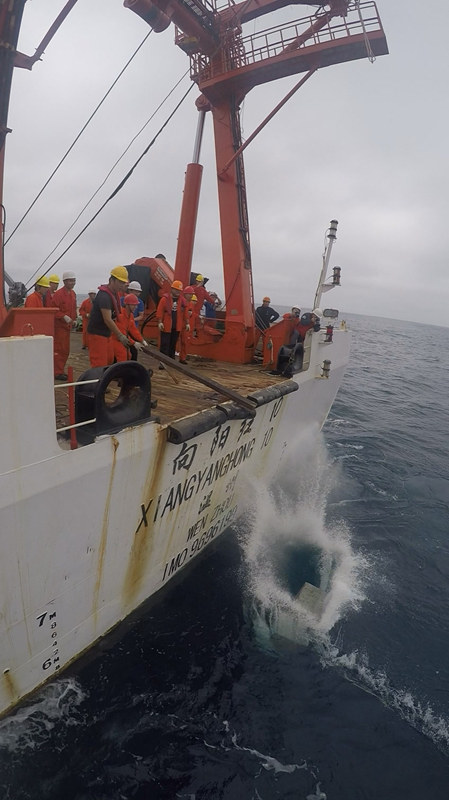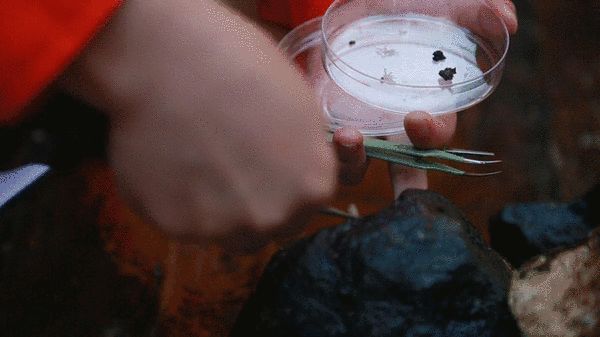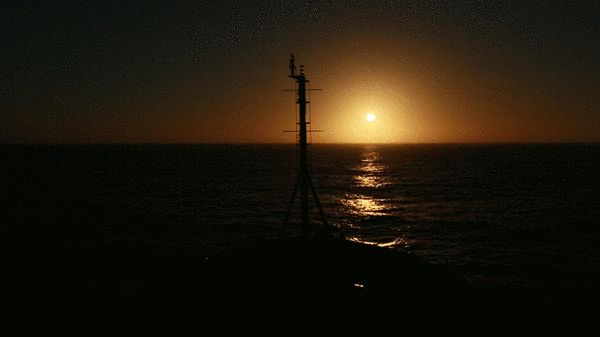Quest oceanic scientific research required before deep diving submarine wrote a suicide note
Dive deep
Underway 29 days at sea, 7070 nautical miles (13000 km) later, on December 20, 43 voyage of the ocean "Xiangyanghong 10" expedition ship, finally arrived in Southwest India ocean research area.
38 scientific expedition team, is nearly 3000 meters deep to find sulfides, implementation of Southwest India Ocean sulfide contract area preliminary survey mission, Sohu focus of people invited to the sea recorded the entire process.
India Ocean 3:20 P.M. 20th, sea state 3, waves two or three meters. Standing in the boat along the dizzy, a little attention would have crashed into the sea.
Expedition team members dressed in overalls, helmet, life jackets, safety shoes, wear a safety rope, standing at the side, start loading on the cable holding the equipment. Behind, 4 rope pulled tight swing, Hang Zhou, Chief Scientist at the site safety supervision.
At the bottom, and anything can happen. Aquanaut Diving risks comparable to astronauts, to write a suicide note before every time the sea bottom.
First sea day, the distant swells like a diving whale catch ship. 9 the albatross fly outside the 5 meter, a white Seagull to onlookers.
First light drag device, equipped with a variety of scientific instruments, is about to touch the sea into the water, submerging into the sea. First Division team, loosen the last of 4 screws, it took two minutes.
3:55, no sea research equipment has finished loading, which at 0.5-0.8 meters per second speed, cable sent to 2900 metres.
Dark sea. Everyone stared at the live camera picture of the return of sediment-water float flying debris like night snow, or giant squid swim flutter with a long nose, and white fish Flash past.
Drag the light above the sea floor began to slow down with 200 meters left. Closer to the sea the more vulnerable, according to past experience, the underwater equipment without signal, touch or collide with the cliffs are not uncommon.
5:22, there are 10 meters hit the bottom. When slowing down to 7.1 m, video signal suddenly disappeared. Zhou ordered 20 metres on the device, signal returns to normal.
5:33, communication is interrupted. After a successful repair, starting from the first five or six meters of the security location drag and drop moving, bottom is not flat, stone more than a metre in diameter, lying on the ocean floor, some straight to the sky.
2860 meters deep, when 4.7 metres above the sea floor, screen suspected hydrothermal eruption of debris, old equipment into the sudden, almost 45 degree slope in front of the cliff. Watch the screen, record class girls "Oh" sound, "don't hit anymore. ”
A minute later, people exclaim – harbour a shrimp like red alert, flashing into the stone. Before long, there appears a blue shrimp, lay motionless.
Only half an hour gone 0.35 miles, still do not seem to find hydrothermal field, called Zhou bridge, then drag 0.2 nautical miles. Sure enough, 6:56, scientific equipment and finally entered the hot hydrothermal fluid anomaly--here a little higher than the surrounding water temperature, it is possible they were looking for sulphides.
Attendant immediately record the transient moment, water depth, underwater location latitude and longitude and other precision data.

Harbour garrison
This first expedition into the bottom of the device, which is the scientific exploration of "advance", worth millions of Yuan.
Geophysics at Peking University graduate Chen Cong Kit 50 m cable, carrying one device to detect hydrothermal anomaly. It like a Silver Cup, more than 40 centimeters, about 5 kg, cost hundreds of thousands of Yuan, will take the lead in monitoring to hydrothermal anomaly, providing guidance for the next expedition.
Integrated operations team leader, second Institute of Oceanography Wang Han Chuang, the cable 30 m, 55 m, equipped with two potential instrument of nature. It can detect the bottom of sulfides and other metal mineral anomalies in the water.
Connection range of submarine equipment and control systems on the ship, is worth hundreds of millions of type a stern racks, cable and winch system. Any piece of equipment down to the bottom, and have to depend on it.
The "advance party" sea lock sulphide target zone, you have to play TV grab, specializing in "picking" – most can submerge to a 4000 m deep seabed, through cameras returned images in real time, in 60 seconds a submarine can grab at least 0.5 tons of rocks and sediments, and sometimes it can also take the opportunity to pull up some sponges, shells, fish and shrimp.
"Xiangyanghong 10" expedition ship, three TVs grab, had participated in more than one voyage of the ocean research mission.
Commensurate with their work, and installed in the bottom of the beam, this device is 10 million Yuan, it can monitor water depth, latitude and longitude, speed, course, drawing thousands of metres deep, "topographic maps", which scientists explore the ocean eyes.
When the expedition ship to complete the job, after leaving the work area, ocean bottom seismograph stationed alone on the bottom, of up to one year. It is equivalent to the Earth to do CT, once the submarine earthquake, it will receive seismic wave, recording a number of precise data, precise position can not only push earthquake, and subsea structures and rock image.
This time, the expedition ship put 9 seismographs in Haiti, were independently developed by China, a cost of just more than 200,000 RMB. Currently in the Pacific, India Ocean, the Atlantic Ocean has wide application.
Several months after the expedition ship will return to the same place, send acoustic signals to get it back. Early recovery success rate is not high, and some drifted to the coast, there are fishing boat happened to be salvaged.
So, just in case, before the sea ocean bottom seismograph, smart says, "safe fishing, reward of 3000 Yuan."

Multiple tasks
First day at sea, Zhou Jianping, Chief Scientist and scientific expedition team said, you are not on their behalf, but rather to represent units, remember that your own roles and tasks.
Wake up each morning, GE Lei of North Sea forecasting Center of State Oceanic Administration, through waves and wind forecast maps, judge the sea conditions, reporting to Zhou and captain.
Zhou ordered job notices, bridge room, weather, satellite stations, control room in place. After checking all normal communications, mechanical systems, and scientific operation begins.
And 29 days before the arrival of expedition area, marine science, Tongji University specializing in the same master's brother and sister Zhang Hongyou, Liu Ziyi, experiments all day long. They are the longest leg work man.
Last August, Zhang Hongyou first went to sea, ran 10 wind, scientific survey ship tilting angle has more than 20 degrees, once more than 30 degrees it may capsize. That night, all wearing life jackets in the restaurants, look around what was thrown to the ground, roll to roll, had a sleepless night.
First half of this year, Zhang Hongyou sea two segments. End of the year, he came again, half of his time in the Sea this year.
From Zhoushan, Zhejiang, across the South China Sea, the Earth's equator, to the southwest of India ocean almost every day at 9 in the morning until 5 o'clock in the afternoon, Zhang Hongyou and Liu Zi was doing an experiment – measuring seawater salinity, alkalinity, dissolved oxygen, gets the filter membrane, BNF train, water logging of chlorophyll and DNA, and so on. Experiment involves three disciplines, filter this process alone takes three or four hours.
To the expedition after the operation, he and sister take 2000 m to 3000 m deep sea water, do the experiment.
Worried about Zhang Hongyou someone working hard to sister Liu Zi asked the second leg continues to stay on the boat. Surprise--the sick a week, many people die after the girl went to sea for three consecutive months, also in the new year at sea.
Their task was both completed this voyage task and gets part of the master's thesis in data and reports to be submitted to the International Seabed Authority.
"Literally means seawater tests, repeated every day. "15th day at sea, he let the Mariners pushed him a bald, shaved his head a large question mark. Usually someone singing, someone is sleeping, he just stayed in the lab next door to deck, jars, while listening to the love, if this is not done the experiment. Stuffy head, bow is a question mark, the rise is smiling, happened to meet recording expedition data per hour, passing girl, he always blushed.
The sea gave him courage. In one sunset, evening xiaguang, he to say to girls: "I like you".

"Staking"
Marine scientific research is destined to be a long war.
Zhou to participate in ocean research for 12 years. He is a veteran of war China Ocean research, participated in the first global research, told the first to discover "Titanic," alongside the scientists.
China is the world's first and the countries of the International Seabed Authority signed contracts for polymetallic sulphides.
In accordance with the contract, first 10,000 square kilometers of International Seabed Authority on the high seas to exploration in China. China this year to complete the preliminary survey, to be completed by 2019 50% "return indicators", for another 3 years to complete the remaining 25% "return indicator", the remaining 2500 square kilometers of sea areas, China has priority rights.
Investigation of China's scientific research results will also be shared by all mankind. This is the international marine scientific research.
In fact, global expedition in developed countries are stationed in the ocean, "staking".
Two-thirds of the Earth is covered by oceans, most of the waters are still uncharted territory. Marine resource that contains and boundless charm, generation generation of deep-sea research, marine scientific research, and half of the Earth, across the sea.
Offshore research operations every second counts. A 50-day first leg ended only less than half a month.
Right now, Zhou will be developed with China underwater autonomous robot-"Dragon, second" battle Ocean 43 voyage of second leg of the expedition.
Busy day. He came to the fore, late at night, the sea, the waves are growing. From another job, leaving less than 6 hours.
Author: Wu Xuefeng
Section source: Sohu, the public of the characters
(Editor: Yang Lei UN873)
2016-12-25 10:46:46
Sohu
探秘大洋科考 深海潜航员下海底前需写遗书
潜入深海
海上走航29天、7070海里(约13000公里)之后,12月20日,大洋43航次“向阳红10”号科考船,终于抵达西南印度洋科考作业区。
38名科考队员,正在近3000米深海寻找硫化物,执行西南印度洋硫化物合同区的初步探勘任务,搜狐《聚焦人物》受邀出海记录全程。
印度洋时间20日下午3点20分,海况3级,涌浪两三米。站在船沿有点眩晕,稍不注意就会坠入海里。
科考队员身穿工作服、安全帽、救生衣、安全鞋,佩戴安全绳,站在船边,开始在光电缆牵上装载设备。身后,4人紧拽止荡绳,航段首席科学家周建平也在现场安全监督。
在海底,什么事都可能发生。潜航员下海的危险系数堪比航天员,每次下海探底前都要写遗书。
海天一线,远处的涌浪像一头潜在水底的巨鲸追赶大船。9只信天翁在5米外翱翔,一只白色的海鸥也来围观。
第一套设备、搭载多种科考仪器的光拖,即将触海入水,潜入海底。第一次出海的科考队员,拧好最后的4颗螺丝,花了两分钟。
3点55分,所有下海科考设备装载完毕,它们以0.5-0.8米每秒的速度,被光缆送往近2900米海底。
海里漆黑一片。所有人盯着实时回传的摄像画面——水中漂浮翻飞的沉积物碎屑像是黑夜的初雪,间或有大鱿鱼扑闪着长鼻子游过,也有白色小鱼一闪而过。
光拖距海底只剩200米时开始减速。越靠近海底越容易出问题,根据以往经验,在海底,设备无信号、触底或与陡崖相撞的情况并不少见。
5点22分,还有10米见底。减速下行到7.1米时,视频信号突然消失。周建平命令将设备上提20米,信号恢复正常。
5点33分,通讯中断。抢修成功后,光拖开始在距海底五六米的安全位置拖拽游移,海底并不平坦,石块动辄直径超过一米,有的躺在海底,有的笔直向天。
在2860米深海,距海底只有4.7米时,画面中喷发出疑似热液的漂浮物,原来是设备撞上了前方突如其来、接近45度坡的峭壁。紧盯画面、记录班报的女生“哎呀”一声,“可别再撞上了。”
一分钟后,一群人又惊呼——海底一只红色的虾像是有所警觉,闪进了石缝。没多久,又有一只蓝色的虾出现,却趴着一动不动。
光拖半小时只走了0.35海里,似乎还没找到热液区,周建平呼叫驾驶台,再拖拽0.2海里。果不其然,6点56分,科考设备终于进入热液异常区——这里热液比周边海水温度稍高,极有可能存在他们要找的硫化物。
值班员马上记录下瞬时时刻、水深、水下定位经纬度等精密数据。

海底驻守
这只是潜入海底的第一套科考设备,它们是科考探秘的“先遣队”,价值数百万元。
北大地球物理学硕士研究生陈聪在这套设备的50米光缆处,搭载了一部探测海底热液异常的设备。它像银色水杯,40多厘米,约5公斤重,造价几十万元,能率先监测到热液异常,为接下来的科考提供指导作用。
综合作业组组长、国家海洋局第二海洋研究所的王汉闯,则在光缆30米、55米处,搭载了两部自然电位仪。它能探测到海底的硫化物等金属矿物在水体中的异常反应。
连接整套海底设备和船上操控系统的,是价值上千万的艉部A型架、光电缆和绞车系统。任何设备下到海底,都得靠它。
“先遣队”下海锁定硫化物目标区域后,就得等电视抓斗上场了,它擅长“海底捞月”——最深能潜入4000米深海海底,通过摄像机实时回传画面,在60秒内一把能抓取至少0.5吨的海底岩石和沉积物,有时也能顺带薅上来一些海绵、贝壳、鱼虾。
“向阳红10”号科考船的三台电视抓斗,都曾参加过大洋多个航次的科考任务。
配合它们工作的,还有安装在船底的多波束,单是这一台设备就要一千万元,它能实时监测水深、经纬度、船速、航向,绘制万米深海的“地形图”,这是科学家探秘海洋的眼睛。
当科考船完成作业、离开作业区后,海底地震仪却孤单驻守在海底,最长一年。它相当于给地球做CT,一旦海底发生地震,它会接收地震波,记录多项精密数据,不仅能反推地震精密位置,还能对海底构造和岩层成像。
这次,科考船投放的9台海地地震仪,都是中国自主研发的,造价一台仅需20多万元。目前它在太平洋、印度洋、大西洋均有广泛应用。
数个月后,科考船会回到原地,发送声学释放信号将其取回。早期它的回收成功率并不高,有的漂流到海岸,也有渔船碰巧将其打捞上来。
所以,以防万一,海底地震仪下海前,都会醒目写着,“安全打捞,重金酬谢3000元”。

多重任务
出海第一天,首席科学家周建平就和科考队员说,你们不是代表自己,而是代表单位而来,记住你们自己的角色和任务。
每天一早醒来,国家海洋局北海预报中心的葛磊,会通过海浪、风场的预报图,判断海况,汇报给周建平和船长。
周建平下达作业通知书,驾驶台、气象室、卫星站、集控室等就位。在检查通讯、机械等系统一切正常后,科考作业才开始。
而在抵达科考作业区前的29天里,同济大学海洋科学专业的同门硕士师兄妹张洪友、刘子一,整天都在做实验。他们是本次航段工作时间最长的人。
去年八月,张洪友第一次出海,就遇上10级风,科考船倾斜角度有20多度,一旦超过30度就有可能翻船。那天晚上,所有人穿着救生衣聚在餐厅,看四处的东西被掀翻在地,滚来滚去,一夜未眠。
今年上半年,张洪友又出海两个航段。年底,他又来了,今年他有一半时间在海上。
从浙江舟山穿越中国南海、经地球赤道,到西南印度洋,几乎每天早上9点到下午5点,张洪友和刘子一都在做实验——测海水盐度、碱度、溶解氧、获取滤膜、生物固氮培养、测海水叶绿素、DNA等等。实验涉及三个学科,光是过滤这一道流程就需三四个小时。
而到科考作业区以后,他和师妹还要取2000米到3000米深的海水,做实验。
担心张洪友一个人忙活不过来,师妹刘子一主动要求第二航段继续留在船上。很多人惊讶——这个晕船一周、死去活来的90后女生,要连续出海三个月,还要在海上过年。
他们的任务是,既要完成本航次任务,又要获取一部分数据做硕士论文,还要给国际海底管理局提交报告。
“其实就是给海水做化验,每天都在重复。”出海第15天,他让水手给他推了个光头,头顶剃出个大问号。平日有人在唱歌,有人在睡觉,他就待在甲板隔壁的实验室,对着瓶瓶罐罐,边听《如果这都不算爱》边做实验。闷着脑袋,低头是个问号,抬头就是笑脸,碰巧遇到每小时记录一次科考数据、擦肩而过的姑娘,他总是脸红。
大海给了他勇气。在一个落日余晖、霞光万丈的傍晚,他向心动的女生表白:“我喜欢你”。

“跑马圈地”
海上科考注定是个长久战。
周建平参加大洋科考12年了。他是征战中国远洋科考的一名老兵,参加过中国第一次环球科考,曾跟第一个发现“泰坦尼克号”的科学家并肩作战。
中国是全球第一个和国际海底管理局签订多金属硫化物合同的国家。
按照合同约定,国际海底管理局先将1万平方公里公海划给中国探勘。中国今年要完成初步探勘,以便2019年完成50%的“返还指标”,再过3年完成剩余的25%“返还指标”,剩余的2500平方公里海域,中国享有优先开采权。
而中国科考调查结果也将为全人类所共享。这是海洋科考的国际公约。
事实上,全球发达国家科考队都驻扎在大洋,“跑马圈地”。
三分之二的地球被海洋覆盖,绝大多数海域仍是未知领域。海洋所蕴藏的无穷资源和无限魅力,让一代代深海科考人、海洋科研者,一次次穿越大半个地球,漂洋过海。
海上科考作业分秒必争。为期50天的第一航段只剩不到半个月就结束。
眼下,周建平即将带着中国自主研发的水下自主式机器人——“潜龙二号”,出征大洋43航次科考第二航段。
忙完一天。他走到前甲板,深夜,大海,风浪正在加大。距离下一场作业,只剩不到6小时。
作者:吴雪峰
稿件来源:搜狐公众号《聚焦人物》
(责任编辑:杨磊 UN873)
2016-12-25 10:46:46
搜狐网